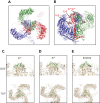Missense mutations in PIEZO1, which encodes the Piezo1 mechanosensor protein, define Er red blood cell antigens
- PMID: 36122374
- PMCID: PMC10644042
- DOI: 10.1182/blood.2022016504
Missense mutations in PIEZO1, which encodes the Piezo1 mechanosensor protein, define Er red blood cell antigens
Abstract
Despite the identification of the high-incidence red cell antigen Era nearly 40 years ago, the molecular background of this antigen, together with the other 2 members of the Er blood group collection, has yet to be elucidated. Whole exome and Sanger sequencing of individuals with serologically defined Er alloantibodies identified several missense mutations within the PIEZO1 gene, encoding amino acid substitutions within the extracellular domain of the Piezo1 mechanosensor ion channel. Confirmation of Piezo1 as the carrier molecule for the Er blood group antigens was demonstrated using immunoprecipitation, CRISPR/Cas9-mediated gene knockout, and expression studies in an erythroblast cell line. We report the molecular bases of 5 Er blood group antigens: the recognized Era, Erb, and Er3 antigens and 2 novel high-incidence Er antigens, described here as Er4 and Er5, establishing a new blood group system. Anti-Er4 and anti-Er5 are implicated in severe hemolytic disease of the fetus and newborn. Demonstration of Piezo1, present at just a few hundred copies on the surface of the red blood cell, as the site of a new blood group system highlights the potential antigenicity of even low-abundance membrane proteins and contributes to our understanding of the in vivo characteristics of this important and widely studied protein in transfusion biology and beyond.
© 2023 by The American Society of Hematology. Licensed under Creative Commons Attribution-NonCommercial-NoDerivatives 4.0 International (CC BY-NC-ND 4.0), permitting only noncommercial, nonderivative use with attribution. All other rights reserved.
Conflict of interest statement
Conflict-of-interest disclosure: The authors declare no competing financial interests.
Figures






Comment in
-
A new blood group system: scientific relevance and media resonance.Blood Transfus. 2022 Nov;20(6):441-442. doi: 10.2450/2022.0264-22. Blood Transfus. 2022. PMID: 36469409 Free PMC article. No abstract available.
-
PIEZO1: now also featuring blood group antigens.Blood. 2023 Jan 12;141(2):123-124. doi: 10.1182/blood.2022018186. Blood. 2023. PMID: 36633886 No abstract available.
References
-
- International Society of Blood Transfusion (ISBT) Red cell immunogenetics and blood group terminology. https://www.isbtweb.org/working-parties/red-cell-immunogenetics-and-bloo...
-
- Daniels GL, Judd WJ, Moore BP, et al. A 'new' high frequency antigen Era. Transfusion. 1982;22(3):189–193. - PubMed
-
- Hamilton JR, Beattie KM, Walker RH, Hartrick MB. Erb, an allele to Era, and evidence for a third allele, Er. Transfusion. 1988;28(3):268–271. - PubMed
-
- Arriaga F, Mueller A, Rodberg K, et al. A new antigen of the Er collection. Vox Sang. 2003;84(2):137–139. - PubMed
Publication types
MeSH terms
Substances
Grants and funding
LinkOut - more resources
Full Text Sources
Molecular Biology Databases

